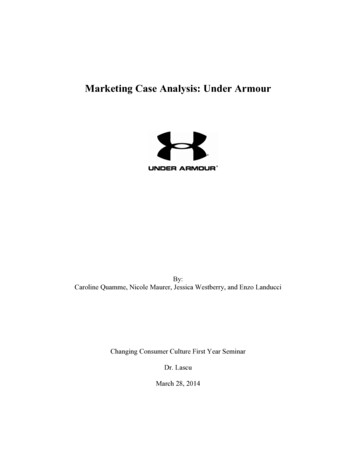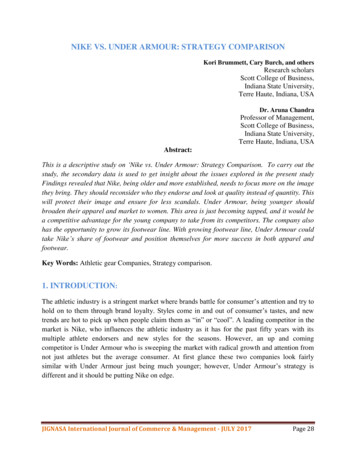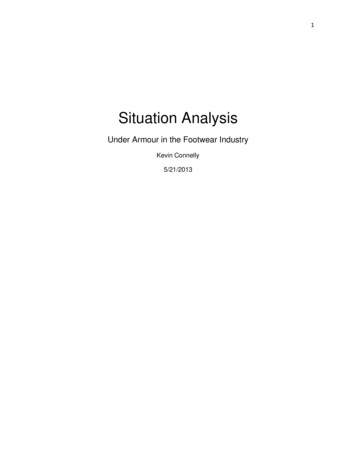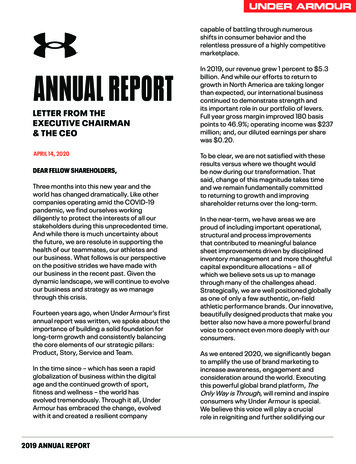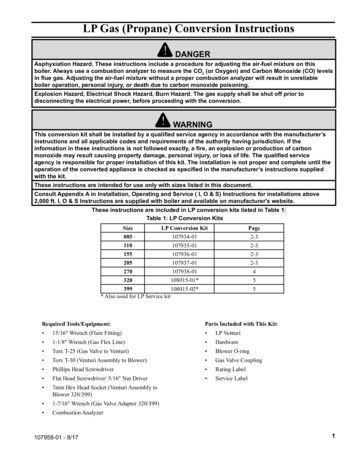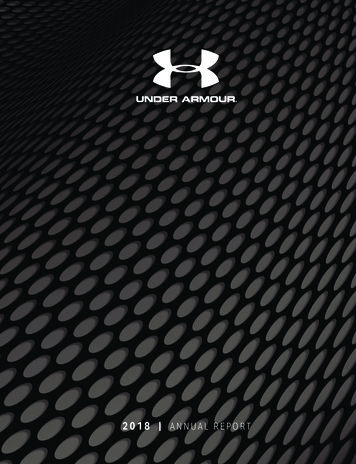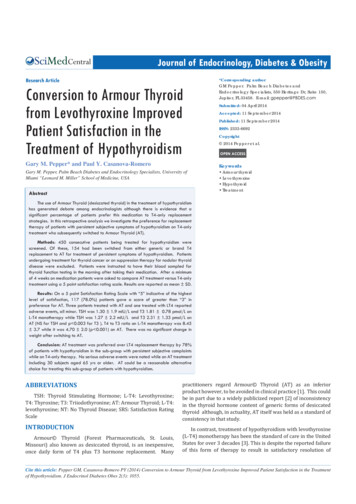
Transcription
CentralJournal of Endocrinology, Diabetes & ObesityResearch ArticleConversion to Armour Thyroidfrom Levothyroxine ImprovedPatient Satisfaction in theTreatment of Hypothyroidism*Corresponding authorGM Pepper. Palm Beach Diabetes andEndocrinology Specialists, 550 Heritage Dr, Suite 150,Jupiter, FL 33458. E-mail:Submitted: 04 April 2014Accepted: 11 September 2014Published: 11 September 2014ISSN: 2333-6692Copyright 2014 Pepper et al.OPEN ACCESSGary M. Pepper* and Paul Y. Casanova-RomeroKeywordsGary M. Pepper, Palm Beach Diabetes and Endocrinology Specialists, University ofMiami “Leonard M. Miller” School of Medicine, USA Armour thyroid Levothyroxine Hypothyroid TreatmentAbstractThe use of Armour Thyroid (desiccated thyroid) in the treatment of hypothyroidismhas generated debate among endocrinologists although there is evidence that asignificant percentage of patients prefer this medication to T4-only replacementstrategies. In this retrospective analysis we investigate the preference for replacementtherapy of patients with persistent subjective symptoms of hypothyroidism on T4-onlytreatment who subsequently switched to Armour Thyroid (AT).Methods: 450 consecutive patients being treated for hypothyroidism werescreened. Of these, 154 had been switched from either generic or brand T4replacement to AT for treatment of persistent symptoms of hypothyroidism. Patientsundergoing treatment for thyroid cancer or on suppression therapy for nodular thyroiddisease were excluded. Patients were instructed to have their blood sampled forthyroid function testing in the morning after taking their medication. After a minimumof 4 weeks on medication patients were asked to compare AT treatment versus T4-onlytreatment using a 5 point satisfaction rating scale. Results are reported as mean SD.Results: On a 5 point Satisfaction Rating Scale with “5” indicative of the highestlevel of satisfaction, 117 (78.0%) patients gave a score of greater than “3” inpreference for AT. Three patients treated with AT and one treated with LT4 reportedadverse events, all minor. TSH was 1.30 1.9 mIU/L and T3 1.81 0.78 pmol/L onL-T4 monotherapy while TSH was 1.27 2.2 mIU/L and T3 2.31 1.33 pmol/L onAT (NS for TSH and p 0.003 for T3 ). T4 to T3 ratio on L-T4 monotherapy was 8.45 3.7 while it was 4.70 2.0 (p 0.001) on AT. There was no significant change inweight after switching to AT.Conclusion: AT treatment was preferred over LT4 replacement therapy by 78%of patients with hypothyroidism in the sub-group with persistent subjective complaintswhile on T4-only therapy. No serious adverse events were noted while on AT treatmentincluding 30 subjects aged 65 yrs or older. AT could be a reasonable alternativechoice for treating this sub-group of patients with hypothyroidism.ABBREVIATIONSTSH: Thyroid Stimulating Hormone; L-T4: Levothyroxine;T4: Thyroxine; T3: Triiodothyronine; AT: Armour Thyroid; L-T4:levothyroxine; NT: No Thyroid Disease; SRS: Satisfaction RatingScaleINTRODUCTIONArmour Thyroid (Forest Pharmaceuticals, St. Louis,Missouri) also known as desiccated thyroid, is an inexpensive,once daily form of T4 plus T3 hormone replacement. Manypractitioners regard Armour Thyroid (AT) as an inferiorproduct however, to be avoided in clinical practice [1]. This couldbe in part due to a widely publicized report [2] of inconsistencyin the thyroid hormone content of generic forms of desiccatedthyroid although, in actuality, AT itself was held as a standard ofconsistency in that study.In contrast, treatment of hypothyroidism with levothyroxine(L-T4) monotherapy has been the standard of care in the UnitedStates for over 3 decades [3]. This is despite the reported failureof this form of therapy to result in satisfactory resolution ofCite this article: Pepper GM, Casanova-Romero PY (2014) Conversion to Armour Thyroid from Levothyroxine Improved Patient Satisfaction in the Treatmentof Hypothyroidism. J Endocrinol Diabetes Obes 2(3): 1055.
Pepper et al. (2014)Email:Centralsymptoms in a portion of treated individuals [4]. Severalgroups have studied the effect of combination L-T4 and T3 asreplacement therapy in an attempt to achieve better clinicaloutcomes. Results have been mixed [5-16] and combinationtherapy remains controversial.A recent [17] prospective double blind study compared theclinical and biochemical response of a group of 70 hypothyroidpatients to AT versus L-T4 monotherapy. Although ratings ofquality of life were comparable between the two therapies,in a sub-group of about 50% of the study cohort AT wasassociated with improved subjective symptoms as measuredby two assessment tools. Additionally 49% of the study grouppreferred AT therapy to L-T4 monotherapy. Interestingly, othersreport patient preference for treatment of hypothyroidismwith combination L-T4 plus liothyronine compared to L-T4monotherapy [9,11].To investigate the observed preference of a subgroupof hypothyroid patients for AT over L-T4 monotherapy, weretrospectively reviewed the biochemical indices of patientswho failed to achieve clinical euthyroidism on L-T4 monotherapyand who were switched to AT treatment. These individuals weresubsequently queried as to their preference for either of thesetherapies.METHODS450 consecutive patients being treated for hypothyroidismwithin a single endocrinology practice were screened betweenFebruary 2013 and April 2013. Of these, 154 (34.2%) had beenconverted to AT after apparent failure of L-T4 therapy to eliminateFigure 1 There were 117 patients who gave a Satisfaction Score of greater than“3”, classified as Group A/ Responders versus 33 giving a Satisfaction Score of “3”or less, in Group B/Non-responders. The mean rank Satisfaction Score for GroupA was 4.79 0.40 compared to 2.70 0.63, for Group B, p 0.001 (**).J Endocrinol Diabetes Obes 2(3): 1055 (2014)Figure 2 Comparison of T4/T3 ratio and TSH between the three groups isshown. The T4/T3 ratio for AT is significantly lower than for both LT4 and NTgroups, 0.0001 (**), while there is no significant difference between LT4 andNT group values. There are no significant differences in TSH levels betweengroups.Figure 3 Distribution of TSH values for LT4 treated patients is shown. Theshaded portion represents the normal range. A log scale is used to display TSHlevels to provide better visual separation of small values.2/7
Pepper et al. (2014)Email:Centralpersistent symptoms of hypothyroidism including fatigue, coldintolerance, constipation, myalgia, and unexplained weightgain. Patients were instructed to take all thyroid replacementmedication while fasting, one hour prior to breakfast. Duringboth L-T4 monotherapy and AT treatment patients werereevaluated at regular office visits generally at 1 to 3 monthintervals with repeat thyroid function testing, physical exams andclinical interviews in an effort to titrate the medication dosage toachieve relief of clinical symptoms without inducing biochemicalhyperthyroidism or hypothyroidism.TSH, total T4, total T3 levels on L-T4 monotherapy andduring treatment were measured. Patients receiving postthyroid cancer replacement therapy (2 patients) or suppressivetreatment for thyroid nodular disease (2 patients) were excludedfrom this analysis. In all others hypothyroidism developed asa result of Hashimoto’s Thyroiditis, other endogenous causes,non-cancer related thyroidectomy, or post-iodine ablation forhyperthyroidism.Patients were asked to compare AT treatment versus priorL-T4-only treatment using a 5 point [11] Satisfaction Rating Scale(SRS). SRS is as follows: 1 AT definitely worse than LT4, 2 ATprobably worse than LT4, 3 AT no different than L-T4, 4 ATprobably superior to L-T4, 5 AT definitely superior to L-T4.Prior to patient interview a minimum of 4 weeks of L-T4 and ATtherapy was completed, unless an adverse event occurred. In aneffort to reduce interviewer induced bias questioning of subjectsand recording of their response was done by a medical assistantprior to the physician’s visit.Figure 4 Distribution of TSH levels for AT treated patients is shown. Theshaded portion indicates the normal range. A log scale is used to display TSHlevels to provide better visual separation of small values.J Endocrinol Diabetes Obes 2(3): 1055 (2014)Separately, 51 ambulatory adults without active thyroiddisease (NT) undergoing routine health evaluation providedsamples for total T4, T3 resin uptake, TSH and total T3measurement. Written consent for use of clinical data wasobtained from all participants. HIPAA compliant protocols forprotection of the privacy of health information were employedthroughout this project.Statistical comparisons of data between treatment groupswere made using a t-test for paired variables; Non parametricdata were analyzed using Kruskal-Wallis one way ANOVA onranks. Results are expressed as mean SD, or mean SEM forgraphical purposes and median for time; p 0.05 is used as thethreshold for statistical significance. Statistical analysis wasperformed using NCSS 2007 statistical program [18].RESULTSCharacteristics of the study population are presented in(Table 1). Of 450 patients being treated for hypothyroidismwith L-T4, 154 (34.2%) had persistent complaints typical ofhypothyroidism despite thyroid hormone levels in the normal orabove normal range. The average age of this study group was53 12.5 years (range 24 to 86 years), 30 of these being 65 yrsof age or older and 139 were female (92.6%). Duration of priorL-T4 treatment was 6 years and 7 months (median 3 years) andfor AT treatment at the time of study was 2 years and 9 months(median 2 years). Three adverse events on AT occurred; itchinessof the eyelids in one, scalp hair loss in one and palpitations inthe third. Tingling and numbness of the lips while on Synthroidconstituted an adverse event during LT4 therapy. AT dose at thetime of study was 92.3 28.6 mg.117 (78%) patients gave a score of greater than “3”(Satisfaction Group A or Responders) vs. 33 patients with a scoreequal or less than “3” (Satisfaction Group B or Non-Responders)(Figure 1). On a 5 point scale, with “5” corresponding to AT“definitely superior” to prior L-T4 therapy and “1” correspondingto AT “definitely worse” the average mean rank score forSatisfaction Group A was 4.79 0.40, significantly greater thanSatisfaction Group B 2.70 0.63 , P 0.001. T4 to T3 ratio on L-T4monotherapy was 8.45 3.7 while it was 4.70 2.0 (p 0.001) onAT, TSH was 1.30 1.7 mIU/L and T3 1.18 0.51 pmol/L on L-T4monotherapy while TSH was 1.34 2.4 mIU/L and T3 1.50 0.86pmol/L on AT (NS for TSH and p 0.003 for T3 ). In both LT4 andAT treatment groups TSH levels were not statistically differentcompared to those without thyroid disease (NT) while T4/T3ratio was significantly lower for AT treatment only (Figure 2).There was no significant change in weight after switching to AT,75.9 15.46 kilograms on L-T4 and 74.40 15.4 kilograms onAT.There was no significant correlation between the satisfactionrating and TSH or between satisfaction rating and change inweight after switching to AT nor was there significant differencebetween TSH levels between any of the 5 groups by satisfactionscore. TSH levels on L-T4 monotherapy and AT were notsignificantly different from NT (1.57 0.73 mIU/L) (Table 2).There were patients in both treatment groups with TSH levelsoutside the normal range however; TSH below 0.4, 58 patientson L-T4 monotherapy (Figure 3) and 61 patients on AT (Figure 4)3/7
Pepper et al. (2014)Email:CentralTable 1: Characteristics of the Study Population.VariablesMeanAge (years)53.5 12.5Baseline Serum T4 on L-T4, (µg/dL)8.3 2.5Baseline TSH on L-T4, (µU/mL)1.30 1.7Baseline Serum T3 on L-T4, (pg/dL)1.2 0.5Baseline Weight on L-T4, (pounds)165.2 34.0Serum TSH on AT (µU/mL)1.35 2.4Armour Thyroid (AT) Dosage (mg)92.3 28.6 Serum T4 on AT (µg/dL)5.9 1.9Serum T3 on AT (pg/dL)1.5 0.9Weight on AT (pounds)163.7 33.9Weight change (pounds)1.25 11.0Serum TSH change (µU/mL)-0.07 2.9Abbreviations: TSH Thyroid Stimulating Hormone, L-T4 Levothyroxine,T4 Thyroxine T3 TriiodothyronineTable 2: Thyroid Functions of the Population without Thyroid Disease(NT).VariablesAge (Years)Serum TSH (µU/mL)Serum T4 (µg/dL)Serum T3 (pg/dL)T4/T3 1Abbreviations:TSH Thyroid Stimulating Hormone,Levothyroxine, T4 Thyroxine, T3 TriiodothyronineL-T4 and TSH above 4.0 mIU/L, 10 patients on L-T4 monotherapy and12 patients on AT.DISCUSSIONThis retrospective observational study represents the findingsof a single out-patient endocrine practice and subjects were notexcluded if they had other intercurrent illnesses common inthis population such as diabetes, hypertension, and neoplasticdisease. These limitations add significantly to the complexityof interpreting our results. The findings however, mirror andexpand on those of a prospective, double blind, cross over designstudy [17] in an unselected group of hypothyroid subjects. In ouranalysis 78.0 % rated subsequent AT treatment as superior whilein the prospective study of unselected hypothyroid patients[17] a 48.6% preference for AT compared to L-T4 monotherapywas reported. Interestingly, in a study [11] comparing LT4to combination LT4 plus LT3, 52.2% preferred combinationtherapy. The higher percentage of patients preferring AT in thepresent study is the expected result of a selection bias for patientsalready dissatisfied with LT4 treatment.Recent studies suggest that due to polymorphism of theD2 deiodinase gene a percentage of the general populationwith hypothyroidism may require higher levels of intracellularT3 then can be provided by L-T4 replacement therapy [12].These individuals would continue to experience symptomatichypothyroidism despite peripheral T4, T3 and TSH levels in thenormal range. In the report by Paniker et al, 16% of the generalJ Endocrinol Diabetes Obes 2(3): 1055 (2014)population exhibited the susceptible genotype. In the presentanalysis, the subgroup of 150 out of 450 patients being treated forhypothyroidism could include a concentration of the populationwith this genotype helping to explain the preference for a T3containing treatment. Future studies providing information ongenetic markers for D2 deiodinase polymorphism in the subgroup of hypothyroid patients with persistent symptoms whoresponded favorably to AT would be invaluable for clarifying thebasis for this preference.TSH levels were comparable on L-T4 monotherapy andAT therapies. In both treatment regimens TSH levels were notsignificantly different than the reference group without knownthyroid disease. Importantly, a portion of each treatment grouphad values above or below the normal range. This is the resultof on-going treatment adjustments required during the processof finding a medication dosage providing maximal relief ofsymptoms of hypothyroidism. While avoidance of medicationtoxicity or under treatment is the ultimate goal, during activemanagement it is not always possible to avoid excursions outsidethese parameters. As opposed to studies employing a fixedmedication dosage the results presented here do not necessarilyreflect the final equilibrium point in management. In fact, thepersistence of symptoms despite low TSH while titrating LT4dosage frequently served as a trigger for a trial of AT in thispractice. Of 58 patients on L-T4 who had TSH levels below thelower limit of normal, only 11 had persistence of this biochemicalabnormality after switching to AT while the rest achievednormalization of this key parameter at the time of sampling.Previous studies of T4 plus T3 therapy suggest that increasedperipheral thyroid hormone concentrations reflected bysuppressed TSH levels [11] could be a factor in the favorableresponse to this therapy. In the present analysis however, therewas no correlation of satisfaction ratings with TSH levels, inagreement with others [11,17].There was no change in weight after switching fromL-T4 monotherapy to AT. These results suggest that clinicalimprovements seen with AT were not due to weight loss ashas been suggested in other studies of combination therapy[11,17,19]Previous studies have shown a significant placebo affectpersisting for up to 12 months, associated with use of combinationL-T4 and T3 treatment [10]. Although some patients reportedgreat improvement in well being occurring within a few daysto weeks of being switched to AT from L-T4, characteristic of aplacebo effect, there was no correlation of duration of treatmentwith satisfaction rating in the AT group. Perception of thesuperiority of AT persisted so that patients still reported theirpreference for AT even after years of use. These finding areagainst the existence of a simple placebo effect as the basis of theresults here.Finally, warnings regarding use of AT in older adults havebeen issued [1,21] although there is no published data tosubstantiate these concerns. In our study 30 individuals over age65 years were successfully treated with AT without untowardevents with a mean treatment duration of 2.87 2.19 yrs in thisolder population, minimum 0.5 to a maximum of 10 yrs on AT.4/7
Pepper et al. (2014)Email:CentralCONCLUSIONAT treatment produced high satisfaction scores in a groupof hypothyroid patients with persistent symptoms on L-T4therapy. Our findings suggest that AT preference is not due toplacebo effect, induction of hyperthyroidism or weight loss. Nosignificant untoward effects of this therapy were noted inclusiveof 30 subjects 65 yrs of age and older. As suggested by Hershman[20], AT seems no more dangerous than adding T3 to L-T4therapy and can be offered to patients who “don’t feel normal”on L-T4 monotherapy. Larger prospective studies would helpclarify what role AT plays in replacement therapy of patientsdissatisfied with L-T4 monotherapy for hypothyroidism. Ourresults are encouraging to clinicians that this drug does provide aviable treatment alternative.DISCLOSUREDr. Casanova-Romero is on the speakers’ bureau of Sanofi. Dr.Pepper has no multiplicity of interest to disclose. This researchwas conducted without funding from any public, commercial, ornot-for-profit agencies. This research was presented in part atthe 83rd Annual Meeting of the American Thyroid Association;Abstract #25, October 17, 2013.REFERENCES1. Garber JR, Cobin RH, Gharib H, Hennessey JV, Klein I, MechanickJI, et al. Clinical practice guidelines for hypothyroidism in adults:cosponsored by the American Association of Clinical Endocrinologistsand the American Thyroid Association. Endocr Pract. 2012; 18: 9881028.2. Rees-Jones RW, Rolla AR, Larsen PR. Hormonal content of thyroidreplacement preparations. JAMA. 1980; 243: 549-550.3. Singer PA, Cooper DS, Levy EG, Ladenson PW, Braverman LE, DanielsG, et al. Treatment guidelines for patients with hyperthyroidism andhypothyroidism. Standards of Care Committee, American ThyroidAssociation. JAMA. 1995; 273: 808-812.4. Saravanan P, Chau WF, Roberts N, Vedhara K, Greenwood R, Dayan CM.Psychological well-being in patients on ‘adequate’ doses of l-thyroxine:results of a large, controlled community-based questionnaire study.Clin Endocrinol (Oxf). 2002; 57: 577-585.5. Bunevicius R, Kazanavicius G, Zalinkevicius R, Prange AJ Jr. Effectsof thyroxine as compared with thyroxine plus triiodothyronine inpatients with hypothyroidism. N Engl J Med. 1999; 340: 424-429.6. Bunevicius R, Jakuboniene N, Jurkevicius R, Cernicat J, Lasas L, PrangeAJ Jr. Thyroxine vs thyroxine plus triiodothyronine in treatment ofhypothyroidism after thyroidectomy for Graves’ disease. Endocrine.2002; 18: 129-133.7. Clyde PW, Harari AE, Getka EJ, Shakir KM. Combined levothyroxineplus liothyronine compared with levothyroxine alone in primaryhypothyroidism: a randomized controlled trial. JAMA. 2003; 290:2952-2958.8. Sawka AM, Gerstein HC, Marriott MJ, MacQueen GM, Joffe RT. Does acombination regimen of thyroxine (T4) and 3,5,3’-triiodothyronineimprove depressive symptoms better than T4 alone in patients withhypothyroidism? Results of a double-blind, randomized, controlledtrial. J Clin Endocrinol Metab. 2003; 88: 4551-4555.Cite this article9. Escobar-Morreale HF, Botella-Carretero JI, Gómez-Bueno M, GalánJM, Barrios V, Sancho J. Thyroid hormone replacement therapy inprimary hypothyroidism: a randomized trial comparing L-thyroxineplus liothyronine with L-thyroxine alone. Ann Intern Med. 2005; 142:412-424.10. Saravanan P, Simmons DJ, Greenwood R, Peters TJ, Dayan CM. Partialsubstitution of thyroxine (T4) with tri-iodothyronine in patients on T4replacement therapy: results of a large community-based randomizedcontrolled trial. J Clin Endocrinol Metab. 2005; 90: 805-812.11. Appelhof BC, Fliers E, Wekking EM, Schene AH, Huyser J, TijssenJG, et al. Combined therapy with levothyroxine and liothyronine intwo ratios, compared with levothyroxine monotherapy in primaryhypothyroidism: a double-blind, randomized, controlled clinical trial.J Clin Endocrinol Metab. 2005; 90: 2666-2674.12. Panicker V, Saravanan P, Vaidya B, Evans J, Hattersley AT, FraylingTM, et al. Common variation in the DIO2 gene predicts baselinepsychological well-being and response to combination thyroxine plustriiodothyronine therapy in hypothyroid patients. J Clin EndocrinolMetab. 2009; 94: 1623-1629.13. Walsh JP, Shiels L, Lim EM, Bhagat CI, Ward LC, Stuckey BG, et al.Combined thyroxine/liothyronine treatment does not improve wellbeing, quality of life, or cognitive function compared to thyroxinealone: a randomized controlled trial in patients with primaryhypothyroidism. J Clin Endocrinol Metab. 2003; 88 4543-4550.14. Escobar-Morreale HF, Botella-Carretero JI, Escobar del Rey F,Morreale de Escobar G. REVIEW: Treatment of hypothyroidism withcombinations of levothyroxine plus liothyronine. J Clin EndocrinolMetab. 2005; 90: 4946-4954.15. Grozinsky-Glasberg S, Fraser A, Nahshoni E, Weizman A, Leibovici L.Thyroxine-triiodothyronine combination therapy versus thyroxinemonotherapy for clinical hypothyroidism: meta-analysis ofrandomized controlled trials. J Clin Endocrinol Metab. 2006; 91: 25922599.16. Nygaard B, Jensen EW, Kvetny J, Jarløv A, Faber J. Effect of combinationtherapy with thyroxine (T4) and 3,5,3’-triiodothyronine versusT4 monotherapy in patients with hypothyroidism, a double-blind,randomised cross-over study. Eur J Endocrinol. 2009; 161: 895-902.17. Hoang TD, Olsen CH, Mai VQ, Clyde PW, Shakir MK. Desiccatedthyroid extract compared with levothyroxine in the treatment ofhypothyroidism: a randomized, double-blind, crossover study. J ClinEndocrinol Metab. 2013; 98: 1982-1990.18. Hintze, J. NCSS. NCSS, LLC. Kaysville, Utah. 2009; www.NCSS.com .19. Celi FS, Zemskova M, Linderman JD, Smith S, Drinkard B, Sachdev V,et al. Metabolic effects of liothyronine therapy in hypothyroidism:a randomized, double-blind, crossover trial of liothyronine versuslevothyroxine. J Clin Endocrinol Metab. 2011; 96: 3466-3474.20. Hershman JM. Patients with Hypothyroidism Taking DesiccatedThyroid Extract Lost Weight As Compared with an Equivalent Dose ofLevothyroxine. Clin Thyroidol. 2013; 25: 122-124.21. The American Geriatrics Society 2012 Beers Criteria Update ExpertPanel. American Geriatrics Society updated Beers Criteria forpotentially inappropriate medication use in older adults. J Am GeriatrSoc. 2012; 60: 616-631.Pepper GM, Casanova-Romero PY (2014) Conversion to Armour Thyroid from Levothyroxine Improved Patient Satisfaction in the Treatment of Hypothyroidism. JEndocrinol Diabetes Obes 2(3): 1055.J Endocrinol Diabetes Obes 2(3): 1055 (2014)5/7
within a single endocrinology practice were screened between February 2013 and April 2013. Of these, 154 (34.2%) had been converted to AT after apparent failure of L-T4 therapy to eliminate . Figure 1. There were 1
